Amorphic Beer Coming to Riverwest
Brewery owners plan to make beer that eschews classification.
What do you try next when your career designing turbine engines for aircrafts and electric propulsion systems for submarines becomes a bore?
If you’re Ron Hockersmith, the logical next step is brewing beer.
Hockersmith left the corporate life behind and started helping out at Company Brewing, drawing upon his experience as a home brewer and an engineer. Now, after putting in some work at an actual brewery for a year, he’s gearing up to open a brewery of his own in the Riverwest neighborhood called Amorphic Beer.
It’s a name that calls to mind white lab coats and test tubes, which isn’t too far off considering that the brewery aims to use data-driven experimentation to achieve certain brews. By definition, the word “amorphic” describes something that lacks an ordered form, and that idea will play into the beer that the brewery creates.
“Our working slogan is ‘beer without shape,’” Hockersmith said.
While a beer doesn’t necessarily have a shape, Hockersmith said its a metaphor that describes the ways in which the beer he creates doesn’t necessarily fit into the classification rules that most breweries adhere to. For example, Hockersmith describes how he might achieve a beer with a strawberry passion fruit aroma.
“We might use a lager yeast, and we might use certain hops that give it a fruity flavor,” Hockersmith says. “Someone could ask me what kind of beer it is, but I don’t know that I care — thus the amorphic. It it an IPA? I don’t know, but it’s between (an IPA and a lager.)”
Amorphic Beer is a partnership between Hockersmith and two of his old work colleagues — Alan Willhite and Joe Broeckert. All three have engineering backgrounds. What started as a small-talk, half-jokingly suggestion of “We should start a brewery” between co-workers blossomed into a full-fledged idea when Hockersmith and Willhite both left their jobs. In need of another mind and another wallet, they brought on Broeckert, who currently works at General Electric.
Hockersmith notes that brewing beer is a combination of art and science, but given the background of the three partners, there is a heavier emphasis on the science side.
“The beer will be very data driven,” Hockersmith says. “We’ll take sensory data from our sales and our patrons and think of ways to use big data. Instead of just taking an ingredient and throwing it in, we want to achieve a flavor, aroma or color.”
“Hops are so versatile — there are hops that taste earthy and hops that taste like smoothies if you use them right,” Hockersmith says. “When I make a pilsner, it has a lot of hops in it, but I don’t want people to think that that means its bitter — it might mean its fruity or it might mean it has aromatics.”
While there are no Amorphic beers currently announced, Hockersmith hinted that a Czech Pilsner that he has been working on is hoppy but not bitter, with a smooth and fruity flavor inspired by a trip he went on to the Czech Republic.
“We’re doing pilot brewing now — every week we make a beer and we evaluate it and decide what we learn from it and process the data,” Hockersmith says. “Then we can decide how we make it better.”
The trio gave themselves a deadline of three months to find a space in which they would open up shop — something that almost didn’t happen until the group was put into contact with Steve Mathison, who owned a building located at 3700 N. Fratney St. with high ceilings, floor drainage and glass garage doors that are popular with breweries these days.
“Our tap room literally looked like a beach,” Hockersmith says.
Amorphic currently doesn’t have an opening date, but Hockersmith and his crew are hard at work finishing more renovations and experimenting with beer. Currently, they’re aiming for a fall opening. To stay up-to-date with the brewery’s opening, follow the Amorphic Beer Facebook page.
If you think stories like this are important, become a member of Urban Milwaukee and help support real, independent journalism. Plus you get some cool added benefits.
























Mr. Hockersmith criticized the German beer drinking gods. Not a good idea.
There is no other country on Earth that takes beer brewing and beer drinking more serious than the people of Germany. A German bartender threw my stepfather out of a Gasthaus when my stepfather complained to the bartender that it was taking too long to finish pouring the head on his glass of beer. The proper pouring of a glass of beer is a skill and an art in German drinking establishments. Some German bartenders can put a head on a glass of beer that’s thicker than whipping cream.
Every beer drinking festival in the world revolves around German tradition.
I’ve been to Germany and consumed my share of German brewed beer. It tasted so good that it made me want to cry. My German relatives consumed American beer when they were here to visit. They said American beer tastes a little bit like dishwater.
If Mr. Hockersmith could replicate the clean, satisfying, mellow feeling that people experience when they drink a glass of German beer, he will have thousands of people lining up at his doors waiting for a taste of his beer.
A Pilgrimage To Meet Germany’s Last Beer-Brewing Nun…
For 50 years, Sister Doris has been master brewer at the Mallersdorf Abbey brewery in northeastern Bavaria. The cloisters were founded in the 12th century and are home to 400 nuns. In the late 19th century, the nuns were caring for hundreds of poor children and they decided to open the brewery in 1881 to raise money to help fund their mission.
She says she drinks, on average, half a liter of beer a day. When she has company, though, she’ll drink a full liter. Bavarian beer, she explains, has around 5% alcohol content — it’s different from north German beers, which have more alcohol and, she says, more calories. “Beer has the least calories of all alcoholic beverages,” insists Sister Doris. “A nice glass of red wine is the equivalent to a liter of my beer.”
When she says this, she notices a puzzled look on my face. I’d heard that beer is more caloric than wine due to its concentration of carbohydrates. “Beer makes you thinner!” she says, patting her belly. “I only look like this because I eat too much chocolate.”
https://www.npr.org/2021/08/23/1026707774/a-pilgrimage-to-meet-germanys-last-beer-brewing-nun